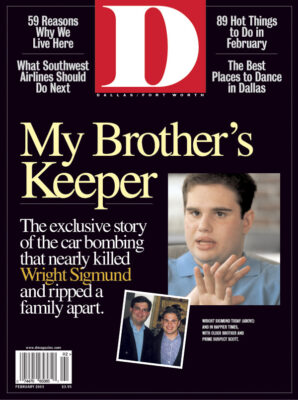My Dinner With Mico
At a historic gathering, the founder of Mi Cocina celebrates the legends of Dallas dining. CLINT SMITH, the Dallas advertising executive, is the kind of person who makes conversation by asking questions. Who are the top three male movie stars? Who are the ugliest people in politics? What books do you have on your nightstand right now? Quick with a quip himself, he produces questions as quickly as Frito-Lay produces corn chips. My wife Christine and I happened to be on the receiving end. We were seated with Smith and his date, Moira Parro, an assistant district attorney, along with Mico Rodriguez and his wife Caroline, at one of four small tables in the Rodriguez’s living room.
CLINT SMITH, the Dallas advertising executive, is the kind of person who makes conversation by asking questions. Who are the top three male movie stars? Who are the ugliest people in politics? What books do you have on your nightstand right now? Quick with a quip himself, he produces questions as quickly as Frito-Lay produces corn chips. My wife Christine and I happened to be on the receiving end. We were seated with Smith and his date, Moira Parro, an assistant district attorney, along with Mico Rodriguez and his wife Caroline, at one of four small tables in the Rodriguez’s living room.
The occasion was one of the most extraordinary dinners I have ever attended, a celebration of the men who created fine dining in Dallas. Among the honorees was Jean LaFont, probably the best chef ever to cook in Dallas. When guests began to table-hop between courses, LaFont—roly-poly, pencil-mustached, with a manner as expressive as a French circus clown—stopped by our table. It was then that one of Smith’s questions struck gold.
A little background: as a young man, LaFont was a rising star in France when he was recruited to be chef of the Rainbow Room atop Rockefeller Center. From there he was lured to Ernie’s in San Francisco. Phil Vacarro brought him to Dallas to be executive chef of his restaurant group, which at the time included the two great stalwarts of Dallas dining: Arthur’s and Old Warsaw. LaFont went on to direct the Pyramid Grill at the Fairmont Hotel and most recently came out of retirement to be chef at Le Rendezvous, which D Magazine named one of last year’s 10 best new restaurants.
So Smith focused on LaFont like a laser beam and asked a question that would never have occurred to me or, I suppose, to anyone but Clint Smith:
“How do you cook an ortolan?”
LaFont’s elastic face began multiple reconfigurations. Like a prayer-card saint struck by a heavenly vision, his eyes rolled upward. His tongue began to move in his mouth. With a deep and satisfied sigh, he plopped down in the nearest chair and then suddenly leaned forward over the table. Without saying a word, from an invisible, tiny object cradled in his left hand, he began a delicate plucking motion.
For connoisseurs, the ortolan is a treat beyond all others. An Old World version of the bunting, it is a small bird famous for its flavor that inhabits agricultural areas throughout Europe. Its status as a delicacy nearly led to the tiny bird’s extinction until, in an act of self-abnegation that shook the culinary world, France two decades ago made the trapping of the ortolan a criminal SOCIETY
offense. A huge controversy flared in France last summer when a film depicted former president François Mitterrand in 1996, with a week to live, holding a last supper with 20 of his closest friends, where the main course was a steaming bowl of ortolan.
LaFont spent five minutes preparing his invisible ortolan at our table, each movement in the preparation and seasoning of the bird as graceful and purposeful as the brushstrokes of a Chinese calligrapher. At the end, he presented it to our table on a plate and made that gesture of thumb and forefinger to his lips that only a Frenchman can make with due solemnity, bestowing the kiss of approval. We applauded.
Chris Ward, the executive chef of Mico’s fine-dining restaurants, who was a student of LaFont’s for seven years, knows what it’s like to follow such an act. Ward—tall, good-looking, soft-spoken—apparently cooks for pleasure when he’s not cooking for a living, and he was busy in the kitchen while all this was going on. He emerged to say a quick greeting and gestured toward the dining room, where the table was reserved for the guests of honor. Rarely have guests of honor so deserved the name, for gathered around one table were names from the pantheon of Dallas dining: not only LaFont but also Riviera owner Franco Bertolasi, cellar master Tony LaBarba, chef George Patrice, chef Ewald Scholz, restaurateur Phil Vacarro, and chef Rene Weibel. “My idea in having this party was that the chefs would cook for me,” Ward said, laughing. “But they refused to work, and so I was stuck with it.”
If Ward needed to whip something up, Mico’s kitchen is the place to do it. A glass partition in the living room displays the professional-sized cooking space, with its stainless-steel refrigerators and ovens, six-burner stove, two frying baskets, 24-inch griddle, 24-inch char-broiler, two sinks, and cold salad space. Mico uses it as a test kitchen for his many enterprises. Every business day starts here at 8 a.m., with staff members gathering to share a cup of coffee and plan the management of the 22 restaurants that will begin to open two hours later.
In homage to his honorees, Ward decided on a “retro menu with a modern flair,” employing ingredients nobody uses anymore. The first course was a little dish he calls Caviar Egg: eggs brouille served with heavy cream whipped with a little vodka in a scooped-out eggshell with a caviar topping, which is so good that it deserves to be renamed for a deposed royal family. For the second course, he served scallops with salsify purée and lobster salad. The main course was side of veal Orloff, with fluted mushrooms and a mélange of vegetables, which happened to be one of LaFont’s specialties at Old Warsaw. As if that weren’t enough, the meal was topped off with the dessert that defined Dallas in the 1960s and ’70s: chocolate soufflé.
Between the second and third courses, while the wine glasses were being freshened and the sound of chatter filled the house, a 6-foot-2 teenager came through the front door and ambled past the tables. “Hey, son,” Mico said. “Done your homework?” The young man before me was black, and the founder of Mi Cocina is brown, so the relationship seemed to me biologically improbable. As it turns out, Brandon Blue is one of “Caroline’s boys,” a sophomore at Midwestern whom Caroline has taken under her wing. Later in the evening, another boy wandered in, this one with a girl at his side. He came up to Mico to discuss which car he was using. Thomas Knight is a sophomore at Brookhaven. Both of these boys live at Chez Mico; Brandon has for four years, and Thomas for three. Both are soccer players like Chris Perez, Caroline’s 20-year-old son, who also attends Brookhaven and with Caroline’s help has started its first soccer team.
Mico and Caroline figure they may have as many as two to four young men like Brandon and Thomas living with them at any one time. In addition, Caroline actively monitors as many as 15 boys at a time—making sure they are doing their schoolwork, taking an interest in their ambitions, helping them stay out of trouble. The thing they have in common is soccer. Caroline told me she grew up immersed in kids’ soccer. Her father was one of the founders of Chamber soccer in the late ’60s, and he coached Dallas’ first all-star youth soccer team, the Hurricanes. On a regular weekend it’s not unusual for her to go to seven soccer games around town where her boys are playing. These aren’t only local boys; three have come from Latin America to live at Chez Mico and to learn English, play on a club team, and compete for scholarships to an American university.
With the boys sauntering through and 5-year-old daughter Bianca playing in the living room, the dinner had the air of one of Mico’s Mexican restaurants: warm, intimate, a family affair.
They say married couples start to look alike, and Caroline and Mico remind me of each other. Caroline carries herself with the same sense of command that a successful entrepreneur like her husband wears like a comfortable shirt. In spite of her ready and warm smile, I suspect it wouldn’t be a good idea to mess with Caroline Rodriguez.
The clanging of a fork against a glass told us the toasts had begun. The formal purpose of the evening now presented itself. The elders were lined up first to be introduced and celebrated. Then came their culinary heirs, the cooks of our dinner: Ward, Tim Bevins of the Mercury, Jon Stevens of the Mercury Grill, Kelsey Sukel of Citizen, and James Johnson of Paris Vendome. LaFont made an elegant testimonial, followed by Ewald Scholz, who made a simple one. It was left to Ward to make the final statement of the evening, but his remarks were interrupted by his old teacher LaFont, who, it seems, had warmed to his subject—which, as it turned out, was himself. When the catcalls began, he surrendered the floor temporarily. It proved to be only a tactical retreat, and as soon as Ward quieted the crowd, LaFont started up where he had left off—which I think was 1968. The ceremony disintegrated in laughter, which LaFont interpreted as approval, giving a bow with a final flourish.
Get our weekly recap
Related Articles

Meet the Dallas 500: Mike Tomon, Co-President and COO of Legends Hospitality




